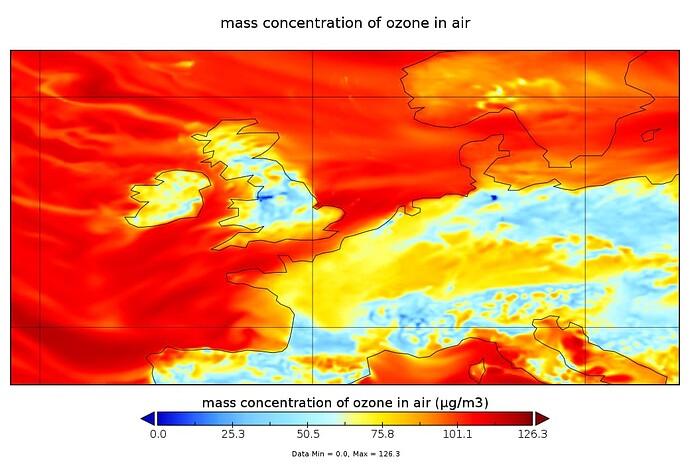I’m having a problem with the European pollution forecast datasets.
I’m downloading PM2.5, PM10, ozone, and nitrogen dioxide data in NETCDF format using the Python API. I used the example in a tutorial to realign the data (time, longitude). Everything works.
Yesterday, I thought, let’s start making ozone forecast maps; summer is approaching, and this pollutant is most prevalent in the summer.
I took the same script as for my PM2.5 maps and changed the variable to ‘o3_conc’. What a surprise! Ozone everywhere in Europe. I did check the documentation online, the data is in µg/m3 : there is no need to do calculation on the data… This isn’t possible. I reran the Python script and tested it on PM2.5 with the same Netcf file. No errors and map consistant with the online models; the o3_conc data are indeed at illogical levels. The online documentation specifies that they are in µg/m3.
This morning, I started again: I downloaded the Ensemble file, ran my script, and I got a map of Europe worthy of a massive pollution episode in summer, with level of 80 to 150 µg/m3
While the online maps show levels consistent with the end of winter.
Am I making a mistake?
In that case, why does the script run on PM2.5 in µg/m3 produce maps that are practically the same as the online ones? And with Ozone wha do I get the same extravagant result with two models (Ensemble, Chimera)?
Voici les concentrations en µg/m3 prévues pour Paris , telles que téléchargées ce matin. Et nous ne sommes pas en épisode de pollution à l’Ozone.
[ 94.48195 94.332794 94.1036 94.052666 95.99651 99.39447
101.165 108.61522 109.313774 108.645096 108.10735 107.50518
107.01602 106.61892 106.42387 108.3643 108.71007 104.47548
101.04122 96.58834 92.46287 91.24051 90.65479 93.394196
99.18949 103.831566 105.792435 106.734665 107.97205 109.02109
111.8721 123.76698 127.78978 126.46398 125.294556 124.62468
123.43796 120.93219 117.623955 112.319664 104.51742 100.41588
99.46962 99.71336 100.40822 101.67059 105.30493 108.884705
110.44176 109.3613 107.586 106.04788 104.462654 102.222305
99.89029 106.58401 108.30053 109.43945 110.12492 110.2863
110.33746 109.034035 107.83513 106.31272 103.22746 100.26753
97.066734 95.08007 93.030975 90.917145 87.48559 83.52737
79.355316 77.52533 76.735886 75.961006 76.554955 77.027374
77.14763 84.73876 88.700714 91.17029 94.741066 97.677475
100.001045 97.445564 93.27144 87.541916 83.926125 86.92828
96.7694 94.55112 90.89128 87.544464 82.49525 78.48448
75.4167 ]
Hi Ronald,
I just downloaded the T+0 ensemble ozone field for today’s forecast. I see values in France in the 50-60 ug/m3 range. Nothing as high as what you’re seeing. Could you let us know the exact field you’re looking at by sharing your data request?
Luke.
I download these datas 
dataset = “cams-europe-air-quality-forecasts”
request = {
“variable”: [
“nitrogen_dioxide”,
“ozone”,
“particulate_matter_2.5um”,
“particulate_matter_10um”
],
“model”: [“chimere”],
“level”: [“0”],
“date”: [“2025-03-16/2025-03-16”],
“type”: [“forecast”],
“time”: [“00:00”],
“leadtime_hour”: [
“0”,
“1”,
“2”,
…
And they produce for Paris the data up.
Hi Ronald,
If I download the 2025-03-16 T+3 field and plot it this is what I get:
Values are around 75 ug/m3 in Northern France, which is around 35ppb at 0 Celsius. That seems roughly consistent with the web chart: Charts | Copernicus
Luke.
1 Like
Well I did not know what happened yesterday , i downloaded the data this morning and all is correct. Values are like yours and correct for the season. Thank you for your answer.
